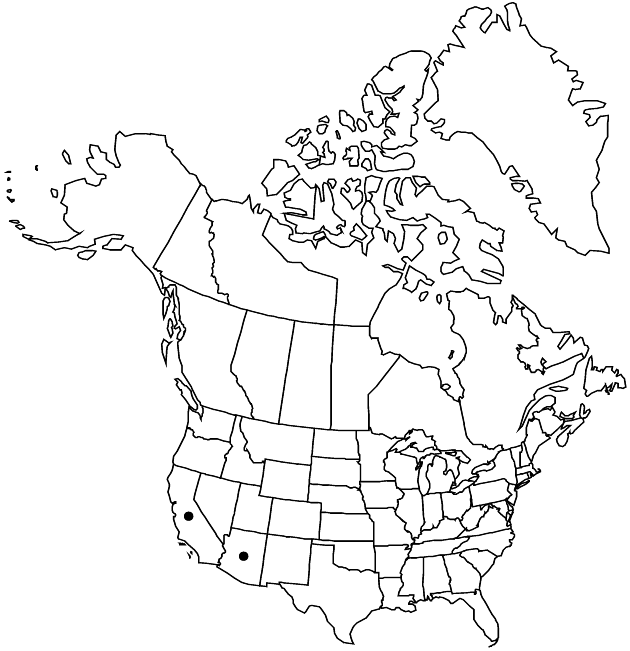Difference between revisions of "Logfia arizonica"
Preslia 70: 107. 1998.
FNA>Volume Importer |
imported>Volume Importer |
||
| (5 intermediate revisions by 2 users not shown) | |||
| Line 8: | Line 8: | ||
}} | }} | ||
|common_names=Arizona cottonrose | |common_names=Arizona cottonrose | ||
| − | |basionyms={{Treatment/ID/ | + | |basionyms={{Treatment/ID/Basionym |
|name=Filago arizonica | |name=Filago arizonica | ||
|authority=A. Gray | |authority=A. Gray | ||
| + | |rank=species | ||
| + | |publication_title=Proc. Amer. Acad. Arts | ||
| + | |publication_place=8: 652. 1873 | ||
}} | }} | ||
|synonyms={{Treatment/ID/Synonym | |synonyms={{Treatment/ID/Synonym | ||
|name=Oglifa arizonica | |name=Oglifa arizonica | ||
|authority=(A. Gray) Chrtek & Holub | |authority=(A. Gray) Chrtek & Holub | ||
| + | |rank=species | ||
}} | }} | ||
|hierarchy=Asteraceae;Asteraceae tribe Gnaphalieae;Logfia;Logfia arizonica | |hierarchy=Asteraceae;Asteraceae tribe Gnaphalieae;Logfia;Logfia arizonica | ||
| Line 39: | Line 43: | ||
-->{{#Taxon: | -->{{#Taxon: | ||
name=Logfia arizonica | name=Logfia arizonica | ||
| − | |||
|authority=(A. Gray) Holub | |authority=(A. Gray) Holub | ||
|rank=species | |rank=species | ||
| Line 54: | Line 57: | ||
|publication year=1998 | |publication year=1998 | ||
|special status= | |special status= | ||
| − | |source xml=https:// | + | |source xml=https://bitbucket.org/aafc-mbb/fna-data-curation/src/2e0870ddd59836b60bcf96646a41e87ea5a5943a/coarse_grained_fna_xml/V19-20-21/V19_738.xml |
|tribe=Asteraceae tribe Gnaphalieae | |tribe=Asteraceae tribe Gnaphalieae | ||
|genus=Logfia | |genus=Logfia | ||
Latest revision as of 19:55, 5 November 2020
Plants 2–10(–20) cm. Stems (1–)3–10, spreading to sometimes ascending; branches usually leafless between proximal forks, becoming purplish to black, glabrescent. Leaves linear to narrowly oblanceolate, largest 15–20(–25) × 1–1.5 mm, pliant; longest capitular leaves 2–5 times head heights, acute. Heads in glomerules of 4–10 in strictly dichasiiform arrays, ± pyramidal, largest ± 4 × 3 mm. Phyllaries 0 or vestigial. Receptacles obovoid, 0.4–0.9 mm, heights 1–1.6 times diams. Pistillate paleae (except innermost) 9–13(–17) in 2–3 series, vertically ranked, loosely saccate, incurved 20–60°, somewhat gibbous, not galeate, longest 2.2–2.7 mm, distal 15–25% of lengths glabrous abaxially; bodies cartilaginous, obcompressed; wings prominent. Innermost paleae ± 5, spreading in 1 series, bisexual and (usually) pistillate. Pistillate florets: outer 9–13(–17) epappose, inner (0–)1–2 pappose. Bisexual florets 4–10; corollas 1.2–1.7 mm, lobes mostly 5, brownish to yellowish. Cypselae: outer incurved, proximally ascending, distally erect, obcompressed, mostly 0.9–1 mm; inner densely muriculate; pappi mostly of 17–23 bristles falling in complete or partial rings, 1.3–2 mm. 2n = 28.
Phenology: Flowering and fruiting mid Feb–mid May(–mid Jun).
Habitat: Seasonally moist clay flats, sandy drainages, coastal slopes, flood plains, rocky places, roadsides, Mediterranean to arid climates
Elevation: 0–1000(–1400) m
Distribution

Ariz., Calif., Mexico (Baja California, Baja California Sur, Sonora).
Discussion
Logfia arizonica is known from southwestern California to northern Baja California Sur to southern Arizona and adjacent Sonora (except Colorado River valley) and from the Channel Islands (Santa Catalina, San Clemente) and Angel de la Guarda, Cedros, and Guadalupe islands in Mexico.
Selected References
None.